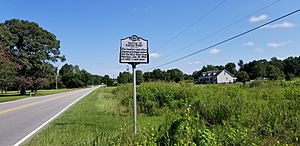Battle of Hayes Pond facts for kids
Quick facts for kids Battle of Hayes Pond |
||||
|---|---|---|---|---|

Lumbee Indians fighting Ku Klux Klansmen during the incident
|
||||
| Date | January 18, 1958 | |||
| Location |
Near Maxton, North Carolina, United States
34°43′07″N 79°21′57″W / 34.71862366859941°N 79.36573253796487°W |
|||
| Caused by | Ku Klux Klan cross burnings and racist threats against the Lumbee community | |||
| Resulted in | Klan rally disrupted | |||
| Parties to the civil conflict | ||||
|
||||
| Lead figures | ||||
|
||||
| Number | ||||
|
||||
| Casualties | ||||
| Injuries | 4 Klansmen injured by gunfire; 3 journalists and 1 witness injured | |||
| Arrested | 1 Klansman arrested by police | |||
The Battle of Hayes Pond, the Battle of Maxton Field, or the Maxton Riot was an armed confrontation between members of a Ku Klux Klan (KKK) organization and Lumbee Indians at a Klan rally near Maxton, North Carolina, on the night of January 18, 1958. The clash resulted in the disruption of the rally and a significant amount of media coverage praising the Lumbees and condemning the Klansmen.
In 1956, James W. "Catfish" Cole, a KKK member from South Carolina, established the North Carolina Knights, a Klan organization aimed at defending racial segregation. In early 1958 Cole focused his efforts on upholding segregation in Robeson County, North Carolina, which had a triracial population of Native Americans, whites, and blacks. Many of the Native Americans were members of the recently recognized Lumbee Tribe of North Carolina, a group having its origins in other indigenous peoples but had grown into a single community around the county. Cole oversaw two cross burnings meant to frighten the Lumbees from racial mixing, and scheduled a Klan rally which he hoped would have a large turnout.
Cole and his Klansmen widely advertised their event, driving throughout the county in a truck outfitted with a loudspeaker to broadcast their plans. The announcements infuriated the Lumbee community and some decided to try to disrupt the meeting. Fearing violence, local law enforcement officials pleaded with Cole to suspend his plans, but he refused. On January 18, 1958, Cole and about 50 Klansmen, most of whom were followers of his from South Carolina, gathered in a leased cornfield near Hayes Pond, a place adjacent to the town of Maxton. Several hundred Lumbees, many armed, arrived and encircled the group and jeered at them. After an altercation in which the single light in the field was destroyed, the Lumbees began firing their weapons and most of the Klansmen fled. Cole hid in a swamp while the Lumbees seized Klan regalia and carried them to Pembroke to celebrate. Police restored order on the field and arrested one Klansman.
Afterwards, Cole and the arrested Klansman were indicted and convicted for inciting a riot. The event was widely covered in the local and national press, which blamed the Klan for the disorder and praised the Lumbees for their actions. Cole never organized another public rally in Robeson County after the incident. In 2011 the Lumbee Tribal Council declared January 18 a "Tribal Day of Historical Recognition".
Legacy and commemoration
Our histories will long record
That perilous advance,
When many a Klansman left the field
With buckshot in his pants.
The clash has been generally remembered under two monikers: the "Battle of Hayes Pond" or the "Battle of Maxton Field". The media dubbed it the "Maxton Riot". In the aftermath of the battle, most Lumbees recalled it as a purely local affair and an action of self-defense for their community from hostile outsiders; they did not see it as a symbolic protest, an attempt to gain national attention, or as a component of the larger American civil rights movement. Local whites also tended to view the Klan rally as the work of outsiders from South Carolina. In 1958, California-based folk singer Malvina Reynolds wrote a song about the incident, entitled, "The Battle of Maxton Field", which satirized the Klan, and was later covered by folk musician Pete Seeger to commercial success.
Since 1958, several Lumbee authors have written accounts of the battle, and the Lumbee Tribe included a recounting in its 1987 petition for full federal recognition to the Bureau of Indian Affairs. Newspapers in North Carolina have periodically cited the clash in their discussions of the Klan and white supremacy. In 2003 the Lumbee Tribe presented 100 "Lumbee Warriors"—persons verified to have been involved in the Hayes Pond battle—with a medal of honor. In 2011 the Lumbee Tribal Council passed an ordinance declaring January 18 a "Tribal Day of Historical Recognition". On June 26, 2018, North Carolina erected a highway historical marker at the convergence of NC Highway 130 and Maxton Pond Road near Maxton to commemorate the event.
In October 2021, politician Charles Graham, a Lumbee from Robeson County, released a video advertisement for his 2022 campaign in North Carolina's 9th congressional district which recounted the battle. The video went viral on the internet, garnering over 4 million views within 24 hours, and 8 million within three days on the social media platforms Twitter, Facebook and TikTok, becoming the most viewed congressional advertisement ever. Graham said he used the event in his campaign to showcase "history where people of all walks of life came together to stand against absolute evil."



